Realizing Our Potential: Ontario’s Poverty Reduction Strategy (2014-2019)
This is an HTML version of Ontario’s new poverty reduction strategy. Learn about new and enhanced programs, services and benefits that will reach more vulnerable people and lead more families toward a brighter future.
Minister’s message

Deb Matthews
Deputy Premier
Minister Responsible for the Poverty Reduction Strategy
President of the Treasury Board
We know there is potential in everyone. We see it every day in the people working and striving to get a good start in life, to raise a family and to contribute to their communities.
Children growing up in poverty have the innate potential of youth. Individuals starting over in a new country see great potential to contribute to their new homeland. Adults going back to school, perhaps after a layoff, are renewing their potential. People recovering from mental illness or addiction are rediscovering their potential. Poverty has many faces, and there are countless circumstances that lead to poverty. But we know there is one overarching path out of poverty: realizing this human potential.
Our government’s renewed, refocused effort to reduce poverty — Realizing Our Potential — is built around and rooted in the determination of people struggling with poverty, those who are trying to get ahead and fully participate in the communities and the province they call home.
I’m eager to lead this effort — because I’m inspired by the progress and resolve Ontarians have already shown in fighting poverty. And I am grateful for the leadership of my predecessor, Teresa Piruzza, who oversaw the consultations and kicked off the development of this new strategy. I also want to acknowledge the continued work of my colleagues, particularly the Honourable Ted McMeekin and other members of the Cabinet Committee on Poverty Reduction and Social Inclusion, whose contributions to our poverty reduction efforts were invaluable.
Our government’s first Poverty Reduction Strategy took steps to stabilize incomes and help break the cycle of intergenerational poverty. And we made great progress: had the federal government done their part and the economy stayed the course, we would likely have met our target.
In our new Poverty Reduction Strategy, we are recommitting to reducing poverty among children and youth through targeted investments and supports. We are also turning our attention to transitioning youth to meaningful employment, education and training opportunities, while expanding our focus to support employment and income security for the most vulnerable in our province.
In our new Poverty Reduction Strategy, we are also putting a focus on housing — in particular, on ending homelessness — to provide the stable foundation that helps people rise out of poverty. When people have a home, they are better able to manage other challenges in their lives. It is an important first step to moving out of poverty. But more than that, ending homelessness is the right thing to do.
As President of the Treasury Board, I appreciate just how important reducing homelessness and poverty are to the province. Homelessness costs Ontario’s economy. Investments in housing can mean savings down the road because people are healthier, more ready for employment, and participating in the community. As we look for ways to make the most of public investments, it becomes clear that human resources are the province’s most valuable asset in overcoming its fiscal challenges. When you leave no one behind, you arrive at a new destination stronger than ever.
A Poverty Reduction Strategy built on realizing Ontarians’ potential must be one that measures progress. It’s about getting the best possible results for the people working hard to leave poverty, and being the best possible partner to community groups working to end poverty.
Over the past five years, we have witnessed the resilience of Ontarians determined to get out of poverty, and the potential that can be realized when supports are put in place and barriers are removed. We have seen the ripple effects of poverty reduction in strengthening our province as a whole. Now more than ever, we know we can all play a role in creating the right conditions and opportunities that allow everyone to pursue a better future.
No one believes poverty is their destiny. No one feels their poverty defines them. No one wants poverty for their children. Everyone has the right to realize their potential. When someone living in poverty envisions a better life ahead, we need to remove the barriers that keep them from fulfilling that potential. In doing so, we’ll discover an Ontario with an even higher quality of life – one that reaches everyone, one that is built by everyone.
Sincerely,

Deb Matthews
Deputy Premier
Minister Responsible for the Poverty Reduction Strategy
President of the Treasury Board
Executive summary

Ontario’s first Poverty Reduction Strategy, Breaking the Cycle, released in 2008, demonstrates that a concerted focus on poverty reduction makes a difference. Ontario has already made significant progress towards reducing poverty in the province. But we recognize that this is a multi-faceted, complex problem. We need a sustained, comprehensive, flexible and results-driven approach. As we heard in our consultations, we need to recognize that poverty has many faces and that tackling this challenge requires a shared effort.
The new Poverty Reduction Strategy — Realizing Our Potential — will expand our poverty reduction efforts to reach more vulnerable people and will continue to reduce poverty in Ontario.
We will continue to break the cycle of poverty for children and youth
Our first Poverty Reduction Strategy put a special emphasis on children and youth, and we made steady progress towards meeting our target of reducing child poverty by 25 per cent. Between 2008 and 2011,1 we lifted 47,000 children and their families out of poverty. We also prevented 61,000 children and their families from falling into poverty in 2011 alone, and prevented many others from falling into poverty over the course of the strategy. Moving forward, we’ll keep working towards this child poverty reduction target, using 2008 as our base year.
The Ontario Child Benefit has had a direct and lasting impact on families by helping to reduce child poverty. Going forward, it will be increased and enhanced to keep pace with inflation.
Providing for the health and wellbeing of children is a moral responsibility and essential to poverty reduction efforts. We will continue to support healthy development and learning for children with an expanded program that provides nutritious breakfasts, snacks and lunches to school-aged children and youth. We will improve children’s long-term health by expanding access to health and dental programs. And we will enhance wellness with earlier identification and treatment of mental health issues in children and youth.
Progress in education is an important factor in ending intergenerational poverty. We will continue to focus on raising achievement in our schools. Access to early learning through full-day kindergarten is now available for every four- and five-year-old across the province. Obstacles to educational achievement will be removed through programs targeting youth at risk, such as summer programs that boost learning and programs that build community in urban high schools.
We are implementing programs to close achievement gaps among learners, with special emphasis on programs that enhance opportunity for Aboriginal youth and youth leaving care. A good education prepares young people for success in life, gives them the tools and skills to find their first job, and leads them on the path to a prosperous future.
1 As of the launch of this strategy, 2011 is the most recent year for which income data is available.
We will move towards employment and income security
Employment income is key to reducing poverty. That is why we have already raised the minimum wage, and why we have introduced legislation to tie its growth to inflation — so working families’ incomes can keep pace with the cost of living.
Getting a good start in the world of work is especially important for young people. Programs that boost youth employment by removing obstacles, enhancing work experience and promoting entrepreneurship will continue. As Ontario invests in economic development to boost job creation, we will pay special attention to examining how these measures can also help reduce poverty.
To connect more people with employment, especially vulnerable populations, Ontario is integrating government-wide employment and training programs to help those most in need access the right supports to become and stay employed.
Too many persons with disabilities who have the capability, skills and desire to work are excluded from the labour market, and the province misses out on their talent as barriers limit their potential. We will support collaborations and partnerships that identify and remove obstacles to employment for persons with disabilities.
Modernizing child care will help ensure that parents who want to work or go to school will have better options for safe and engaging child care. We’ll also look at other services and supports, such as exploring long-term options to extend health benefits to all low-income Ontarians, which can provide more people with the opportunity to move beyond social assistance.
To maintain an effective social safety net for those in need and to help people access jobs and achieve greater financial independence, we will continue to reform social assistance.
A good income provides the means for a life of dignity. Steady work provides the confidence to keep moving forward. But to be ready for a day’s work — in a job or at school — people need a place to call home.
We will establish a long-term goal to end homelessness in Ontario
A person without a home is unable to get out of poverty. To reduce poverty, we need to work towards ending homelessness. But to solve a problem, you must be able to measure it. As we lack the data to effectively tackle this issue in the short term, we are embarking on the upfront work to figure out where we stand, and will develop solutions based on evidence. Researchers and experts, including people with lived experience, will assist us in defining a baseline and setting a new homelessness-related target in the years ahead.
As we do this work, we will place special emphasis on housing supports for those who are homeless or at high risk of losing their homes. We have seen numerous examples, in communities of all sizes, where finding or staying in a secure home provides the basis for children succeeding in school, young people finding their way, adults getting a job and vulnerable people having a sense of security.
We also know that stable housing, along with the right services and supports, improves wellness for people with addictions and mental health issues, providing not only a place to live but a focal point for receiving other services they need.
Since 2003, Ontario has committed over $4 billion to affordable housing initiatives. We will continue working with the federal government to improve access to affordable housing by building and renovating more units. We will be updating Ontario’s Long-Term Affordable Housing Strategy, launched in 2010, to reflect lessons learned and integrate new research on best practices related to housing and homelessness.
As with all measures in the new Poverty Reduction Strategy, we will be focusing on approaches that get the best results for people living in poverty.
We will use evidence-based policy to measure success
To guide our direction, we are recommitting to our ambitious target to reduce child poverty by 25 per cent, using 2008 as our base year, and we are setting a new goal to end homelessness. To ensure we know where we are and how much further we need to go, we will improve the government’s ability to accurately measure our progress. We will set a target to measure our success.
We are committed to funding programs based on evidence. We will work within government and with our community partners to place a heightened focus on evidence-building and fund programs and interventions that work for people. We will challenge ourselves and our partners to work collaboratively towards better outcomes, and reward these efforts with a commitment to sustained funding for those programs that achieve success for people living in poverty.
To provide a better indication of where efforts are needed, and which investments are working, we’re creating new indicators to look at youth, long-term unemployment and vulnerable populations more closely. To help good ideas get a head start, we’re creating a Local Poverty Reduction Fund to build evidence, reward local solutions that get results and help them to grow.
Through the strategy, we want to take social policy development to the next level and become a leader in evaluation in order to achieve the best results.
We will realize the potential of all Ontarians
Ontario’s first Poverty Reduction Strategy began the important work of tackling poverty in a comprehensive and coordinated way. The new Poverty Reduction Strategy will continue many of the efforts already underway and add to this momentum through new strategic investments. As we move forward, we will work with our partners and with individuals to develop solutions based on collaboration. We have heard from Ontarians that there are many faces to poverty. Our efforts will be as varied and diverse as our people. Poverty reduction must reach all those who need it, so we can realize the tremendous potential that exists within the people of Ontario.
Introduction
Vulnerable groups
We know that some groups are more vulnerable to poverty than others, including Aboriginal peoples, newcomers, persons with disabilities, unattached individuals aged 45 to 64, and lone parents. That is why we will more closely track their poverty rates — to ensure our efforts are having an impact on those most affected by poverty.
For so many people living in poverty, a better life is just beyond their grasp. Access to child care might open up a world of possibilities. A good stretch of hands-on work experience can launch a lifelong career. An inspiring education program can build confidence in youth, spark their imagination and help them realize their potential to become a role model for other young people. An affordable home can provide the stability for a single mother to plan for the future — with a roof over her head and a permanent address to put down on her resume.
If the Ontario in which we want to live is a place where people can take that last step out of poverty, then we need to work to make it happen.
Realizing Our Potential will build on the progress we have made to date. It is a pragmatic plan — one that puts evidence and results first. Recent economic growth has been modest, as the economy continues to adjust to new global realities. So, we need to fix our sights on steady progress in a continuously evolving economy. We know it’s not possible to address every issue all at once, but we can be creative in making full use of the resources we do have. There is no single line in the Ontario Budget that will end poverty with the stroke of a pen, but we can strike at its root causes strategically, effectively and relentlessly.
The road to a new Poverty Reduction Strategy
The collective spirit of the people of Ontario is at the heart of our new Poverty Reduction Strategy. In late summer and early fall 2013, we commissioned research, consulted with a Technical Advisory Group, and travelled across the province to hear Ontarians’ perspectives on poverty reduction. More than 800 people participated in our consultations, over 65 formal submissions were provided, and over 2,000 responses were collected through market research and an online survey.
Ontarians spoke passionately about their views, and what they thought should happen next. We heard a number of common themes throughout the consultation process, including the desire for our government to expand the focus beyond children and youth, to recognize that some groups are at higher risk of poverty, to use an inclusive and comprehensive approach, and to work more closely with our partners.
All of this feedback was essential, and we want to sincerely thank each and every person, organization and community that shared their ideas. Contributions from Ontarians illuminated various aspects of poverty. Informed voices spoke to the need for further action. Every Ontarian will benefit, directly or indirectly, from this commitment to public service and community-building. And for this, we thank you.
Building on progress: Ontario’s first Poverty Reduction Strategy
In 2008, our government introduced Ontario’s first Poverty Reduction Strategy, Breaking the Cycle. It was a launching pad for the important work that we needed to do and showed that placing a concerted focus on poverty reduction makes a difference in people’s lives.
Addressing poverty is a public policy priority. When 1.57 million people live in poverty2 in as prosperous a place as Ontario, there is a clear need to adapt public supports and investments — education, housing, health care and mental health care, jobs, training and other services — to the reality of everyone’s current circumstances. Reducing poverty is about reaching those most in need across the province, and about making government investments and partnerships work better for everyone.
In 2008, under our first strategy, we set an ambitious target of reducing child poverty by 25 per cent over five years. We made progress, reducing child poverty from 15.2 per cent in 2008 to 13.6 per cent in 2011. In the first three years of our Poverty Reduction Strategy, 47,000 children and their families were lifted out of poverty. In 2011 alone, 61,000 children and their families were prevented from falling into poverty, and many others were prevented from falling into poverty over the course of the strategy. More families now feel the simple, private victory of believing they can get ahead in life, instead of worrying about whether or not they’ll get through the month. Since 2003, the income of a single parent with two children, working full time at a minimum-wage job, has gone from less than $20,000 per year to over $34,000 per year.
Supporting working families

When we dedicate our focus to reducing poverty, we make progress. We have made progress on all of the measures set out in our first strategy. We made the largest investment in affordable housing in Ontario’s history. We created the Ontario Child Benefit (OCB), a cornerstone of the first strategy, and now invest approximately $1 billion in the OCB each year. Because of the OCB, fewer families with children need to turn to social assistance. And for many parents, it makes it easier to leave social assistance for the workforce, knowing they will continue to receive support for their children.
We knew from the outset of our first strategy that a strong federal partner was crucial to achieving our target. Unfortunately, the federal government did not make adequate investments to help Ontario meet our goals. At the same time, a global recession and the worst economic downturn in 20 years impacted our ability to achieve our target. But we did our part, and we know that poverty rates would have been much worse without our efforts.
Ontario’s interventions make a difference
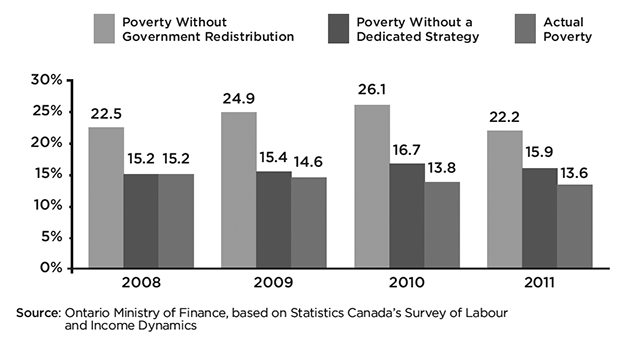
Numbers never tell the whole story, however. Breaking the cycle of poverty was not just about reducing the number of children in poverty but also about looking to the future. It was about making sure that many others did not fall into poverty, and about helping those living in poverty to have greater access to the tools required to build a better life. It was about providing the social support, education and training opportunities that people need to help them overcome barriers to social inclusion and employment. Through substantial investments in education, skills training and employment, we know that our efforts had a broad and long-term impact on those living in poverty and those prevented from falling into poverty. Realizing Our Potential will continue this important work.
Despite ongoing economic pressures, our government will continue to be there for those who are most in need. Reducing poverty is a complex challenge, but we can make steady and solid progress towards this goal through hard work, sustained effort, creative thinking, focused partnerships with other levels of government, and a strong evidence base.
We know there is much ground to cover and that it will require innovation in all sectors and collaboration across all levels of government. And we invite all of our partners, and all Ontarians, to join us in achieving our shared goal of reducing poverty and creating a more equitable and fair province.

2 Defined as those households with incomes below the Low Income Measure (LIM), which is 50 per cent of median adjusted after-tax household income. Our first Poverty Reduction Strategy used the LIM fixed to a base year of 2008 and adjusted to the Ontario Consumer Price Index for subsequent years. We will continue to use the 2008 base year for the new strategy. The decision to rebase to a more current year will be considered in the next Poverty Reduction Strategy.
Poverty interrupted: continuing to break the cycle for children and youth
We are shaped by the quality of our childhood. Parents understand this intuitively, and try to give their children the best possible experiences. We act on this belief as a society, too, investing in public education, health care, community infrastructure and other supports to ensure that children get the best start in life.
Research backs this conventional wisdom. Interventions during childhood are the best way to reduce the possibility of lifelong poverty. Our new Poverty Reduction Strategy remains committed to breaking the cycle of poverty with continued and strategic investments in the lives of children and youth.
Child benefits: A solid foundation
When children live in families experiencing poverty, especially prolonged poverty, they can’t find a way out on their own. Children are the most vulnerable to the effects of poverty. That is why the first poverty reduction strategy focused on helping kids, families and communities. And that is why we continue to call on the federal government to increase the National Child Benefit Supplement. The Ontario Child Benefit was the cornerstone of the first Poverty Reduction Strategy. It supports about one million children in over 500,000 low- to moderate-income families.

Building on progress:
The Ontario Child Benefit (OCB) will continue to play an important role in improving the everyday lives of children and their families under our new strategy. In July 2014, the maximum annual benefit was increased to $1,310 per child.
Beginning in July 2015, the OCB maximum annual benefit and its income eligibility threshold will be indexed to the Ontario Consumer Price Index. This means that the OCB will be adjusted for inflation each year. Keeping up with inflation makes it easier for families to afford the rising costs of basic necessities, such as nutritious food. This will help maintain the gains achieved through the OCB now and in the future.
Student nutrition: more seats at the table
When children are hungry, they can’t focus on their learning. It disrupts attention. It leads to frustration. Before the day has even begun, a hungry student is already falling behind. The Student Nutrition Program helps provide nutritious breakfasts, snacks and lunches to school-aged children and youth in communities across Ontario, including those in higher-needs communities. During the 2012-13 school year, the program served more than 695,000 school-aged children and youth.
Building on progress:
Our government will expand Ontario’s Student Nutrition Program so that an estimated 56,000 more children and youth in higher-needs communities can access a nutritious breakfast or morning meal at school. An initial investment of an additional $32 million over the next three years will establish 340 new breakfast programs in elementary and secondary schools and enhance support to some existing student nutrition programs.
We will also expand the Student Nutrition Program to some on-reserve schools in First Nations communities. This expansion gives First Nations communities the opportunity to lead the development of student nutrition program models that will address the unique strengths and needs of each community.
Health benefits: the fundamentals of success
Children in Ontario should never experience poor health as a consequence of the difficult financial choices faced by low-income households. Parents should never have to choose between work and social assistance, just so that their kids can get the health care that they need. Access to adequate and timely critical extended health benefits and services, such as prescription drugs, improves health outcomes. We know — and were reminded during our consultations — that good health is an important part of exiting and preventing poverty.
Building on progress:
We recently expanded income eligibility for Healthy Smiles Ontario — our integrated low-income dental benefit program for children and youth. Byexpanding income eligibility for this program as of April 1, 2014, approximately 70,000 more children and youth became eligible to receive dental services.
Building on this program, we are also committed to providing health benefits for children and youth in low-income families to ensure these kids have access to services that fall outside of publicly funded health care, including prescription drugs, vision care, mental health services and assistive devices.

Mental health: early identification and treatment
Good mental health is as important as good physical health. It is estimated that 20 per cent of Ontarians will experience a mental health issue at some point in their lives, with 2.5 per cent of Ontarians having a serious mental illness.3 The unemployment rate of individuals with serious mental illness ranges from 70 to 90 per cent, depending on its severity, which puts them at a greater risk of poverty.4 Ontario’s economy is also negatively affected when people with mental health issues are unable to work.
We know that mental health and addictions issues often begin early in life: 70 per cent have their onset during childhood and adolescence.5 Young people between the ages of 15 and 24 are three times more likely to have a substance use problem than people over the age of 24, and about 24 per cent of deaths among 15- to 24-year-olds in Canada are due to suicide.6
With this in mind, our government launched the 10-year Comprehensive Mental Health and Addictions Strategy: Open Minds, Healthy Minds. In the first three years, we focused on children and youth — because we know that early interventions can prevent further mental health issues and provide greater prospects for stable health, independence and employment later in life. More than 55,000 kids and their families are now benefiting from significant investments that total $93 million in new annual funding. Services and supports focus on fast access to high-quality services, early identification and helping vulnerable kids with unique needs.
Additional supports are helping to ensure that mental health issues are identified and treated early. For example, an expansion of the Tele-Mental Health Service to Aboriginal, rural, remote and underserved communities includes providing 29 telemedicine units to First Nations communities, trainingfor Aboriginal mental health and addictions workers, hiring more than 80 Aboriginal mental health and addictions workers in high-needs Aboriginal communities, and developing and implementing a provincial youth suicide prevention plan that includes an Aboriginal component.
Building on progress:
We will continue our work to improve mental health services for children and youth by taking the next step. Our action plan, Moving on Mental Health, will transform the experience of children and youth with mental health issues. The plan focuses on creating the conditions where, regardless of where they live in Ontario, children and youth with mental health issues and their families will know what mental health services are available in their communities and how to access the services and supports that meet their needs.
To build on this work, Phase 2 of the Comprehensive Mental Health and Addictions Strategy (years four to 10) includes a long-term comprehensive approach to transforming the mental health and addictions system for adults. As this work expands, we will continue to work collaboratively with First Nations and Aboriginal communities.

3 Health Canada, A Report on Mental Illnesses in Canada (Ottawa, Canada, 2012), http://www.phac-aspc.gc.ca/publicat/miic-mmac/pdf/men_ill_e.pdf.
4 Canadian Mental Health Association (Ontario) & Centre for Addiction and Mental Health, “Employment and Education for People with Mental Illness,” (discussion paper, January 8, 2010), http://www.ontario.cmha.ca/backgrounders.asp?cID=449205.
5 Government of Canada, The Human Face of Mental Health and Mental Illness in Canada (Ottawa, Canada, 2005), http://www.phac-aspc.gc.ca/publicat/human-humain06/pdf/human_face_e.pdf.
6 Government of Ontario, Open Minds, Healthy Minds: Ontario’s Comprehensive Mental Health & Addictions Strategy (2011), http://www.health.gov.on.ca/en/common/ministry/publications/reports/mental_health2011/mentalhealth_rep2011.pdf.
Education: success for all learners
There are many contributors to success, but access to education is key to helping children and youth realize their potential. Over the past 10 years, Ontario has made outstanding gains in improving student achievement. In 2003, only 54 per cent of children in Grades 3 and 6 met our high provincial standards in literacy and numeracy. Today, it is 72 per cent. In 2004, only 68 per cent of students were graduating from high school. Today, 83 per cent of students are graduating. That means there are an additional 138,000 high school graduates in Ontario because of the education reforms of the past 10 years.
Ontario high school graduation rates
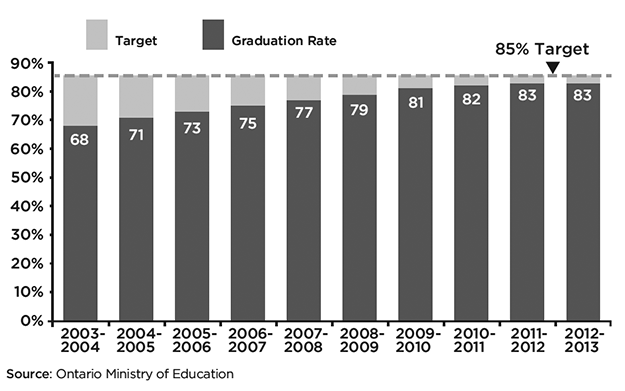
Our work over the past decade included a focus on removing barriers — including poverty — that prevent students from reaching their potential. Performance gaps among students of different backgrounds have narrowed and in some cases, closed. According to the Organisation for Economic Co-operation and Development, Ontario is one of the best places in the world for not only having higher than average achievement in reading, but also lower than average differences in the performance of students from different socioeconomic backgrounds.7
To further reduce poverty, we will maintain our focus on education, especially for children from low-income families, Aboriginal students, children and youth in care, children and students with special education needs, and newcomers.
7 Education Quality and Accountability Office, “Programme for International Student Assessment (PISA), 2009: Highlights of Ontario Student Results,” (December 2010), http://www.eqao.com/pdf_e/10/2009_PISA_Highlights_en.pdf.
Achieving excellence and ensuring equity: realizing our kids’ potential
As soon as any student starts talking about what they’d like to be some day, their dreams should become our shared goal. Over the past 10 years, we have proven that collaboration and partnership for a common purpose — success for our kids — can yield impressive results. By continuing to work together, we will create an education system that will give our children the knowledge and skills they need to embrace the challenges of the future, and the resiliency and creativity to seize opportunity.
Building on progress:
We’ve launched Achieving Excellence: A Renewed Vision for Education in Ontario, which sets out four ambitious goals for the sector:
- achieving excellence — children and students of all ages will achieve high levels of academic performance, acquire valuable skills and demonstrate good citizenship. Educators will be supported in learning continuously and will be recognized as among the best in the world
- ensuring equity — all children and students will be inspired to reach their full potential, with access to rich learning experiences that begin at birth and continue into adulthood
- promoting wellbeing — all children and students will develop enhanced mental and physical health, a positive sense of self and belonging, and the skills to make positive choices
- enhancing public confidence — Ontarians will continue to have confidence in a publicly funded education system that helps develop new generations of confident, capable and caring citizens
Full-day kindergarten and early learning: a strong start
Full-day kindergarten is one of the most significant improvements made to Ontario’s education system in decades. The program is giving children a stronger start in life through early learning programs. For any child of any background, high-quality early learning can help to identify learning needs at an earlier stage, so they can get the additional support they need to succeed.
Early learning also gives us a jump on closing achievement gaps. Our approach to kindergarten offers children a full day of learning that will help them develop the social, emotional, academic and physical skills that provide a good foundation for success in school and in life. By the time children from low-income families start school, they may already face disadvantages compared to their peers from higher-income families. Enriched education environments, such as the one provided by full-day kindergarten, can help to close that gap.
Full-day kindergarten also helps parents living in poverty by providing more time in the day to pursue education, training or employment while reducing child care costs by approximately $6,500 per year.
Building on progress:
As of September 2014, full-day kindergarten will be fully implemented and accessible to all families with four- and five-year-olds.
Building on the before- and after-school programs offered for full-day kindergarten students, Bill 10, the Child Care Modernization Act, 2014, if passed, would ensure that school boards offer before- and after-school programs for six- to 12-year-olds, where there is sufficient demand, either themselves or through a third party.
Vulnerable youth: removing barriers, building potential
“Right away, students feel a sense of belonging, of being at home. It gives them a leg up on the experience of being at Samuel-Genest. It feels like it’s where they are meant to be.”
Réal Charette, a principal whose school used the Urban and Priority High Schools Initiative to design activities that significantly reduced anxiety for students entering Grade 7 at Collège Catholique Samuel-Genest in Ottawa, which runs to Grade 12
Ontario is committed to excellence for all students, supporting student wellbeing both in and outside of the classroom, and creating an equitable education system where all youth — regardless of their circumstances — feel welcomed and included.
The Urban and Priority High Schools Initiative, for example,provides positive experiences that keep students in school in communities facing challenges such as poverty, conflict with the law, academic achievement issues and a lack of access to community resources.
The Summer Learning Program providesstudents from kindergarten to Grade 3 withclassroom learning and recreational activities in the summer. Instead of returning to school in September a little rusty and having forgotten lessons from the last academic year, they return feeling engaged and optimistic about the year to come.
The After School Program helps sport and recreation organizations deliver quality programs for children and youth in priority neighbourhoods across the province. Each year, the program ensures thousands of kids are able to participate in fun, safe, supervised activities, while also offering working families more flexibility in the critical after school hours.
Building on progress:
Working with education and community partners, we’ll continue removing barriers and improving student achievement and wellbeing through the Urban and Priority High Schools Initiative, the Summer Learning Program, and the After School Program.
To help more students overcome barriers that might otherwise discourage them from postsecondary education, we will help Grade 12 students apply to college, university or an apprenticeship program through the Life After High School program.
Aboriginal education: closing an unacceptable gap
Some First Nations, Métis and Inuit students struggle academically to achieve at the same level as other Ontario students, with gaps of up to 51 percentage points on provincial standardized assessments as compared to all students. The Aboriginal Education Strategy works toclose these gaps and improve First Nations, Métis and Inuit student achievement and wellbeing.
Building on progress:
TheAboriginal Education Strategy will continue working towards two primary objectives: to improve the student achievement and wellbeing of First Nations, Métis and Inuit students, and to close achievement gaps between Aboriginal students and other students. The strategy will continue to support the vision that First Nations, Métis and Inuit students in Ontario will have the knowledge, skills and confidence they need to successfully complete their elementary, secondary or postsecondary education or training and/or to enter the workforce and the traditional and contemporary knowledge, skills and attitudes to be prosperous.
We’re also supporting Aboriginal students through the Postsecondary Education Fund for Aboriginal Learners. It provides $30.5 million to colleges, universities, Aboriginal postsecondary education and training institutes and community stakeholder organizations to support the success of Aboriginal learners. The fund also provides $1.5 million in bursaries for Aboriginal students.

Former Crown wards and youth leaving care: supporting the first steps to adulthood
“On one particular day, the teacher asked what the students would like to learn in school, and this student said that she would like help finishing her income tax return, the first time she’d spoken in circle. The teacher arranged for someone to come in and assist students with their taxes. From that point, this student began participating more in class. She went on to earn one of the highest marks and was accepted to college, while becoming one of the most motivational students in the class.”
A story from one of 20 pilots in 18 school boards for students in care of or receiving services from a Children’s Aid Society
Former Crown wards and youth leaving care may be young adults, but many are still vulnerable. They can face a number of challenges as they transition to adulthood. If they want to pursue postsecondary education to prepare for a successful life and avoid falling into poverty, we need to help them. That’s why we created the 100% Tuition Aid for Youth Leaving Care program that covers tuition fees at all universities and participating colleges in Ontario. We also created the Living and Learning Grant, which provides $500 per month during the school year to help former youth in care with their living expenses while they are attending postsecondary education.
Building on progress:
We’ve launched the Youth-in-Transition Worker Program with a $4.2 million annual investment to employ workers who provide support to youth aged 16 to 24 who are leaving care. These workers connect youth to services and supports in their communities to meet their needs, including housing, education, employment, skills training and health services.
In addition, the Ministry of Education is providing almost $2 million for Children and Youth in Care innovative program pilots aimed at creating conditions for success for secondary school students in care. Students will benefit from learning opportunities, supports and interventions to improve their educational achievements, and to close the achievement gap.
Youth Equity Lens
Government investments should reflect the needs of all citizens, especially youth who are at risk of poverty. This includes homeless youth and youth facing barriers, Aboriginal youth, youth in and leaving care, youth with disabilities or special needs, Lesbian, Gay, Bisexual, Transgender, Two-Spirited and Queer (LGBTTQ) youth, newcomer youth, and youth living in rural and remote communities.
The Youth Equity Lens was created by the Ministry of Children and Youth Services to examine various government policies and programs from a youth perspective. By looking across government with an eye to increasing opportunities and reducing barriers for vulnerable youth, Ontario can make smarter investments in one of our most valuable assets — the natural optimism of young people.
Working against poverty: moving towards employment and income security
While focusing on education can help ensure children break out of — and avoid — poverty tomorrow, there are still people of all ages living in poverty today. For most of them, meaningful employment is the most effective and speediest way to exit poverty for good.
Our new Poverty Reduction Strategy will continue to clear the way for individuals to enter the workforce, to feel engaged in the life of their communities and to benefit equitably from Ontario’s prosperity.
Helping youth transition to the workplace: getting a break makes a big difference
Ontario’s youth unemployment rate remains considerably higher than that of the province’s working-age population. Long spells of youth unemployment can lead to a “scarring” effect — lower wages and a higher likelihood of becoming unemployed later in life. Ontario’s new Poverty Reduction Strategy, like the first, will keep working to provide opportunities to youth — to help them discover what they’re good at and to show employers what they can do.
The Ontario Youth Apprenticeship Program gives youth the skills, training and experience that lead to a career. In 2013-14, there were 21,603 students in Grades 11 and 12 participating, allowing them to graduate with both their secondary school diploma and partial completion of a qualification in a trade.
We’re also investing $295 million over two years in Ontario’s Youth Jobs Strategy, which is helping young Ontarians find jobs, start their own businesses and gain valuable skills. It’s particularly focused on helping vulnerable youth who face multiple barriers to finding employment, including those from high-needs communities and youth with disabilities. By establishing the Youth Employment Fund, the Youth Entrepreneurship Fund, Youth Skills Connections and the Youth Innovation Fund, our government is supporting initiatives that will help youth find work, build job skills or start their own businesses. To date, the four funds have created 20,000 job opportunities for young people wishing to break into the employment market. We are well on our way to meeting our target of creating 30,000 opportunities for youth.
The Youth Jobs Strategy programs will continue helping youth receiving social assistance, communities with high youth unemployment, Aboriginal youth, youth with disabilities, and youth with limited education.
Building on progress:
Under our new Poverty Reduction Strategy, we will continue supporting the Youth Employment Fund, which has already helped over 18,000 young people find jobs, get training and gain valuable work experience. Early results indicate that 95 per cent of Youth Employment Fund clients who have completed their job placements have gone on to further employment or training.
Ontario is committed to learning from the success of the Youth Employment Fund’s targeting of priority groups. Our government will explore opportunities to leverage investments in economic development, infrastructure, skills and training to yield benefits for specific populations at risk of poverty, in line with the objectives of our Poverty Reduction Strategy.
We will also continue to deliver the Youth Entrepreneurship Fund, which supports youth in becoming entrepreneurs by providing mentorship, training and assistance in accessing capital in order to develop and launch their own businesses. Our government is investing $45 million to help Ontario’s next generation of entrepreneurs.
Supporting entrepreneurship among vulnerable youth
One program being delivered through the Youth Entrepreneurship Fund is the Strategic Community Entrepreneurship Projects program, which supports youth facing multiple barriers to employment to gain the skills necessary to implement a self-employment venture or small-scale business. There has been a strong Aboriginal uptake of the program, at 39 per cent. In one case, a 16-week entrepreneurship training and business support program delivered by the Kenamatewin Native Learning Centre is helping 24 low-income, at-risk Aboriginal youth in Kenora and surrounding areas.
Youth Jobs Strategy
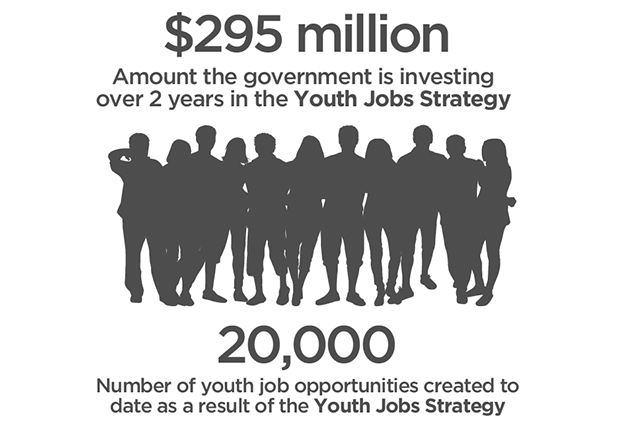
Ontario is partnering with CivicAction to increase private-sector employment and mentorship opportunities for youth. CivicAction engaged with the private sector, labour, youth and government to identify immediate and long-term employment, mentorship and entrepreneurship opportunities for youth facing multiple barriers. CivicAction has identified practical, private-sector-led actions to help all youth succeed and, with government, is now planning to implement these actions in collaboration with the private sector and community partners. The results and impact of these actions will be shared publicly, including insights to support private-sector partners across the province to take action locally.
Removing barriers to employment for the most vulnerable: supports for long-term success
Government employment programs are about connecting job seekers with job creators: helping Ontarians find the right job for them, and helping employers find the people they need. Ontario’s employment and training system is an important part of the social infrastructure that helps to reduce poverty. For example, in 2013-14, Employment Ontario’s Employment Service helped over 600,000 Ontarians find and keep jobs through access to job search, matching, placement, training and retention supports at over 400 locations across the province.
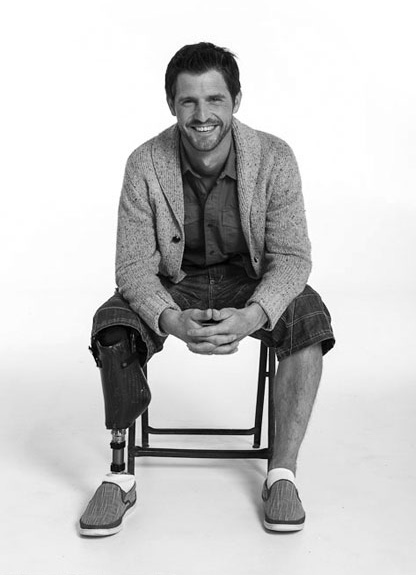
Building on progress:
Through the integration of our employment and training services,Ontario is focusing its resources on those who need them most, including those receiving social assistance, persons with disabilities, the long-term unemployed, Aboriginal people, newcomers, and at-risk youth, to help them access the supports they need to become and stay employed.
Integration will help those in poverty or at risk of falling into poverty to access the system more effectively and move along the continuum towards stable employment and long-term success. We are doing this by working towards the introduction of a new, more consistent approach to assessing clients’ unique barriers to employment, by expanding the range of supports available for people facing barriers or at risk of not succeeding at employment, and by tracking clients’ journeys through the system to make sure they are making progress.
We are working with employers to make sure that everyone is part of the solution and that Ontarians get the skills they need to be successful in the workplace. We will be partnering with employers to launch a series of pilots that will help low-skilled Ontarians, in particular, gain industry-specific skills training for in-demand occupations.
We are also committed to supporting employment for persons with disabilities and to helping employers overcome misconceptions about the capabilities of persons with disabilities. By correcting myths and addressing stereotyping, Ontario can promote the contributions of persons with disabilities and benefit from their skills. The new Poverty Reduction Strategy will continue collaborations with businesses and community employers to foster partnerships to establish inclusive workplaces.
Building on progress:
We’ll bring together people from business, labour, academia, government and not-for-profit organizations to share ideas and develop new approaches. With advice from the Partnership Council on Employment Opportunities for People with Disabilities, this effort will include talent development initiatives focused on educational attainment, skills training and early experiences with the labour market for persons with disabilities.
Augmented education initiative
George Brown College and the Centre for Addictions and Mental Health (CAMH) have partnered to develop and deliver an employment-geared training modelfor people with mental health and/or addictions issues who face challenges in achieving success in regular college programming. The focus of these training programs is to prepare students for jobs in the hospitality and construction sectors. To support these programs, Ontario has provided annual funding of $283,400 over the past three years.
Aboriginal peoples: supporting employment and income security
As we heard in our consultations, it is critical that Ontario move forward on a number of fronts to improve economic opportunities and support sustainable employment for Aboriginal people in Ontario, and we are doing so. We are introducing initiatives to increase the participation of First Nations, Métis and Inuit partners in mining, forestry, green energy and other areas. These initiatives will help ensure that Aboriginal people have the opportunity to succeed and fully participate in the workforce and the economy.
Building on progress:
The Jobs and Prosperity Fund includes $25 million over three years to improve access to financing and skills training for Aboriginal people and businesses, as well as new support to diversify Aboriginal economies through a new Aboriginal Economic Development Fund.
Ontario is also providing up to $30 million over 10 years to the Métis Voyageur Development Fund to support Métis economic development and entrepreneurship.
Women in poverty
Certain groups of women are disproportionately affected by poverty, particularly Aboriginal women, newcomers and single mothers. To help women living in poverty build a better future, Ontario has a number of programs that help low-income women, as well as abused women, gain new skills and access new career opportunities. These programs include the Employment Training Program for Abused/At-Risk Women, the Women in Skilled Trades and Information Technology Training Program and the Microlending for Women in Ontario Program.
Spotlight on Success: The True Self/Debwewendizwin Program provides culturally centred employment-readiness and Microsoft Office training for Aboriginal women in the Nipissing Region. The program also welcomes all women in the region, with specific outreach to francophone women, rural women and women with disabilities. Partners include Amelia Rising Sexual Assault Centre of Nipissing, Canadore College, Nurture North, People for Equal Partnership in Mental Health and Nipissing University.
Child care: giving parents time to improve their employment prospects
Parents living in poverty, especially single parents, have child care responsibilities that affect their ability to improve their family income. High-quality child carehelps parents pursue — with peace of mind — a good job or a course of study.
Since 2003-04, our province has doubled funding for child care to more than $1 billion annually.
Building on progress:
We are supporting the modernization of child care by investing an additional $33.6 million to protect licensed child care spaces and provide subsidies to improve the quality of care. We have also introduced Bill 10, the Child Care Modernization Act, 2014, which, if passed, will support informed choices about child care options, increase access to quality child care for families in Ontario, and strengthen the quality of child care and early years programs.
Opportunity missed
Ontario works closely with its municipal partners to support a stable, high-quality child care system, but meeting demand will require partnership among all levels of government. In 2006, the federal government eliminated the Early Learning and Child Care Agreement and cut $1.3 billion over three years in support payments for Ontario. We are committed to highlighting the need for a national investment in child care and working with the federal government to support greater access to quality child care and early years services in Ontario.
Help for the working poor: ensuring their financial stability
Working, low-income Ontarians need support to protect their financial stability and wellbeing. We need to ensure that people who have left social assistance are not forced to go back to access benefits. The first Poverty Reduction Strategy recognized this by making the Ontario Child Benefit available to all low-income families, including those with parents who were working.
Building on progress:
As we heard in our consultations, the risk of losing access to health benefits can be a barrier for people wanting to leave social assistance for employment. Building on the government’s commitment to extend health benefits to low-income children and youth, we will begin work, including consultations, to explore long-term options to extend the health benefits program to all low-income Ontarians.
We increased the minimum wage to $11 per hour, and are proposing to index it to the Ontario Consumer Price Index to ensure that it keeps up with the cost of living.
Ontario’s General Minimum Wage

We’ll continue calling on the federal government to make further enhancements to the Working Income Tax Benefit (WITB), an earned income supplement that makes a difference in the lives of working low-income Ontarians. While recent investments by the federal government to enhance the WITB are a step in the right direction, more needs to be done.
A modernized social safety net: beyond social assistance
Maintaining an effective social safety net for those in need is an important part of poverty reduction. Since 2003, social assistance rates have increased by a cumulative 17.2 per cent for Ontario Works families and individuals with disabilities receiving Ontario Disability Support Program (ODSP) benefits. For single people without children receiving Ontario Works, the cumulative increase is 24.4 per cent. The first Poverty Reduction Strategy included a review of social assistance in Ontario to look for ways to ensure that our system does not itself become a barrier.
Guided by recommendations from the Commission for the Review of Social Assistance in Ontario, we announced initial changes to the social assistance system to help people move into jobs and achieve greater financial independence, and to set the stage for long-term transformation. We focused on increasing the lowest rates and changing the rules so that people can earn more without reducing their assistance, and get help from Ontario Works when they need it without depleting all of their assets.
Building on progress:
We’re continuing to reform the social assistance system as a key component in our poverty reduction efforts.
This year, we again increased support by one per cent for families receiving Ontario Works and individuals receiving ODSP benefits. We also continued to increase the lowest rates, and single adults without children who receive Ontario Works now receive an additional $30 per month. This means that, overall, these single adults without children now receive $50 more each month than they did in 2012.
The rate increases reflect a new investment of $114 million annually by 2016-17.
Success story: Families First
In 2000, Peel Region created Families First, a program for sole-support parents who receive Ontario Works assistance. Ontario Works, Peel Health and Peel Children’s Services work together to support the whole family. Parents build self-esteem and confidence through employment training and access to health and mental health services. There are visits with a public health nurse, subsidized child care and recreation for the kids. Children who would not normally get the chance have been able to take part in Brownies or Cadets, sports camps, swimming lessons or gymnastics. With supports in place, Families First participants are on average 1.3 times more likely to exit social assistance than their Ontario Works counterparts over a 24-month period: a total of 61.7 per cent of those in the initiative exited social assistance after 24 months, compared to 46.4 per cent of their Ontario Works counterparts. On leaving the program, Peel saw a decrease of 83 per cent in those clients reporting Ontario Works as their primary source of income.
“As a mom, if you’re okay, your kids will be fine.”
“I have a child with health issues and I didn’t know where to go for help…the nurse helped me get information and daycare.”
“My children are playing soccer…they love playing with other kids…they didn’t get to do that a lot.”
People living in remote northern communities, particularly First Nations, can face disproportionately high costs for basic necessities like groceries. Recognizing this, we’re replacing the current Northern Allowance provided through Ontario Works and ODSP with the new Remote Communities Allowance. Through the Remote Communities Allowance, clients will receive an additional $50 per month for the first person and $25 for each additional family member, over and above the amount provided through the current Northern Allowance. That’s an overall increase of 10 per cent for a single person without children receiving Ontario Works in a remote community.

Our commitment to seniors
According to Statistics Canada’s Low Income Measure, the number of seniors living in poverty in Ontario decreased from 33 per cent in 1978 to 8.5 per cent in 2011. This is a trend that we are determined to see persist and one that we will continue to track, and we are making investments to support it. Our new strategy will continue to provide provincial supports to seniors in order to help them live with dignity and enjoy continued income security in retirement.
The new Ontario Retirement Pension Plan will help to ensure that today’s workers can maintain their standard of living in retirement, after a lifetime of contributing to Ontario’s communities and economy. The plan will help working families build a more secure retirement. It will provide a predictable stream of income, indexed to inflation, and paid for life in retirement. The plan will also return long-term economic benefits to Ontario when payouts help people maintain their standard of living and continue spending in retirement.
Low-income seniors in Ontario who qualify will continue to have a guaranteed minimum income through monthly payments from the Guaranteed Annual Income System (GAINS). The monthly GAINS payments are in addition to the federal government’s Old Age Security pension and benefits, including the Guaranteed Income Supplement.
Seniors in Ontario will continue to receive up to $500 a year through the Ontario Senior Homeowners’ Property Tax Grant, to help pay their municipal property tax bills so that they can afford to remain living in their own homes. Over a five-year period, the grant is expected to help more than 600,000 seniors with about $1 billion in property tax alleviation.

Right at home: a long-term goal to end homelessness in Ontario
The Ontario Child Benefit provides extra money to buy nutritious food for kids, but you need somewhere to cook it. Education provides a path out of poverty, but you need a place to rest and study. Connecting people with health services and offering employment training help to pave the way out of poverty, but you need an address to access them.
Many people in Ontario struggle to keep a roof over their heads, but that doesn’t mean the problem is insurmountable. We have seen successes that confirm this is a problem we can solve with the right choices. Our government is learning from these successes, and applying the lessons learned. But there’s more work to do in order to tackle the problem in an evidence-driven way.
Research tells us that a Housing First approach, where people experiencing homelessness obtain permanent housing and appropriate supports, is more cost-effective over the long term than emergency responses. The idea behind Housing First is that when people have a stable home along with the right services and supports, they are better able to manage other challenges in their lives. It is an important first step to moving out of poverty.
Our government is committing to end homelessness. We are doing so to shine a brighter light on this problem. We are doing so to demonstrate our commitment to finding housing solutions for Ontarians at all places along the homelessness to housing continuum — whether they need a safe roof over their head tonight, along with access to wraparound supports and services, or help to pay the rent so they can maintain stable housing over the long term.
Homelessness to housing continuum

A long-term solution requires that we continue to transform how we approach homelessness and move away from short-term solutions in favour of finding and addressing the root of the problem. It means doing more to prevent homelessness in the first place. It means spending money in the right way and on the most effective programs and services. In short, it requires us to invest in the right things now so we are not forced to pay a lot more later.
We know this is an ambitious task. We will start by seeking expert advice to develop new measures to track homelessness in Ontario. With the right information and the right tools, we will then develop a plan to reach our goal. We will report back annually on our progress.
Long-term affordable housing: keeping up the momentum
Our government is committed to a solid foundation for people to secure employment, raise families and build strong communities. In 2010, this vision led to the creation of our Long-Term Affordable Housing Strategy to improve access to adequate, suitable and affordable housing.
We created and amended legislation to enhance flexibility for local communities and municipalities to deliver housing and homelessness services, tailored to their needs. Under our new Poverty Reduction Strategy, we are building on that momentum, especially in focusing more closely on those who are currently homeless or at risk of being homeless in the near future.
Building on progress:
We are aiming to end homelessness by making investments in homelessness prevention, expanding access to supportive housing, and investing in more affordable housing. We are updating the Long-Term Affordable Housing Strategy by 2015-16, so that housing policies are relevant to current realities and reflect new research and best practices.
Flexibility for local housing solutions
The District of Cochrane Social Services Administration Board, in response to local need, was able to use Community Homelessness Prevention Initiative (CHPI) funding to address a crisis situation by providing funds to the Red Cross to help families at risk of being homeless.
The City of Ottawa is combining CHPI funds with funds from the Investment in Affordable Housing for Ontario program to create affordable supportive housing.
The City of London is using CHPI funds to secure housing for people discharged from hospitals to ensure that no one is discharged onto the streets.
Homelessness prevention: a community effort
People experience homelessness in different ways and for different reasons. Aboriginal people, LGBTTQ youth, persons with disabilities, sole-support families, and seniors can find themselves homeless or at higher risk of homelessness for a variety of reasons. And Ontario communities experience the issue of homelessness in different ways.
As we set out with our ambitious goal to end homelessness, we know that the best responses to homelessness reflect this diversity of people’s circumstances. That is why we introduced the Community Homelessness Prevention Initiative (CHPI). This program encourages local and tailored solutions through a Housing First approach.
The CHPI allows municipalities and local governments to use flexible program funding to develop homelessness programs tailored to their communities’ needs. For example, funding that once had to be used for emergency shelter beds can now be used to provide stable housing and support services. This makes it easier to provide permanent homes for people in need and is better for local communities and the people they serve.
Building on progress:
Through the Community Homelessness Prevention Initiative (CHPI), Ontario committed to provide municipalities and local governments with $251 million in 2014-15 to prevent and reduce homelessness in their local communities. Under the new Poverty Reduction Strategy, our government is enhancing funding for the CHPI by $42 million starting in 2014-15, to a total of almost $294 million per year.
We know that the realities of homelessness and the required supports look different for youth and adults. Providing homeless or at-risk youth with the right kinds of housing and other wraparound supports is an important part of breaking the cycle of poverty.
Spotlight on success:
Peel Youth Village provides safe, stable, transitional housing and support services for youth aged 16 to 30 who have experienced or are at risk of homelessness. Peel Youth Village provides both short-term and transitional housing to assist youth in every aspect of transitional living and help them to transition to independent living. Peel Youth Village receives support through the Region of Peel’s CHPI funding.
Ensuring that vulnerable, homeless youth can access wraparound supports and services in one place means that they are more likely to succeed. That is why we fund Young Parent Resource Centres across the province. They provide services and supports, such as education and housing supports, to over 5,000 vulnerable youth each year, including pregnant and parenting youth and their children. Many of these young women are caught in the cycle of poverty, considered high-risk, have been involved with the child welfare system, and have histories with domestic violence or substance use problems. The right supports at the right time can help break the cycle.
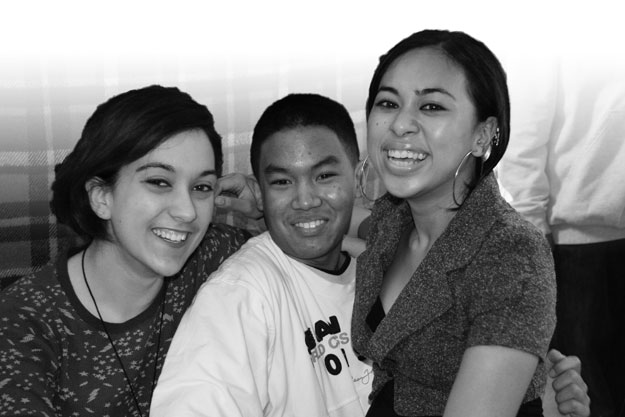
Working with experts on homelessness measurement
Homelessness is a complex problem to tackle, and we currently lack the right data to effectively measure and address the issue. That is why we will seek expert advice, including from those with lived experience of homelessness, to help us define the problem, understand how to measure it and collect the data, and to advise us as we set a target related to ending homelessness. Across the province, there are success stories to emulate and knowledge to be shared. We want to get it right so we can end homelessness for good.
Mental health and addictions: a place to get better
In Canada, it is estimated that a significant number of homeless people have a mental health issue.8 When a person with mental health and/or addictions issues loses his or her home, the situation goes from bad to worse. When a person with mental health and/or addictions issues is already homeless, he or she is much less likely to access programs and services.
Homelessness moves people further from the help they need to be well. We need to move them closer to that help by providing a home where they can focus on getting better. And, as we heard in our consultations, we need to make sure that the help they receive is in the form of wraparound services that best reflect their needs.
At Home/Chez Soi was a four-year research demonstration project funded by the Mental Health Commission of Canada. The program provided stable housing and support services to people with complex mental health and addictions issues who were homeless for an average of 2 ½ years.
Building on progress:
The federal investment in At Home/Chez Soi ended in March 2013. Our government will keep it going. In February 2013, our government committed to continuing to fund this important supportive housing project by investing $4 million. This funding provides 240 people with serious mental health issues living in 216 units in Toronto with rent supplements and support services to enable them to live successfully in their communities. Through the provision of quality housing and recovery-oriented services, people also see improvements in other areas of their lives, such as health, quality of life and reduced interaction with the justice system. At Home/Chez Soi is now a part of the province’s community mental health system, where it fits into the spectrum of supportive housing services provided in Ontario.
Fast fact
An evaluation of At Home/Chez Soi found that for high-needs participants, every $10 investment in Housing First supports resulted in a savings of up to $21.72 (in averted costs for hospitalizations and other services). Participants also spent fewer nights in shelters or at emergency departments.
Under Phase 2 of the Comprehensive Mental Health and Addictions Strategy, Ontario is building on the first three years of the strategy and taking a more comprehensive, person-centred approach. We are improving transitions for youth moving to adult services and expanding the strategy to include people with addictions as well as adults, through additional investments of over $65 million in 2014–15, growing to about $83 million annually by 2016–17. The strategy will promote mental health and wellbeing for all Ontarians, ensure early identification and intervention, expand housing supports, employment supports and an integrated health and social service coordination model, and provide funding based on need and quality of services.
Building on progress:
Our government will allocate $16 million over three years to create approximately 1,000 new supportive housing spaces. Through this initiative, we are working to leverage funding under the extension of the Investment in Affordable Housing for Ontario program and support better local coordination between municipalities/local governments and Local Health Integration Networks in meeting the needs of individuals with mental health and addictions issues.
8 Health Canada, A Report on Mental Illnesses in Canada (Ottawa, Canada, 2012), http://www.phac-aspc.gc.ca/publicat/miic-mmac/pdf/men_ill_e.pdf.
Affordable housing: a place to call home
Our government recognizes the critical need for more affordable housing in Ontario, and that demand far outweighs available supply. That is why, after the 2015 Pan/Parapan American Games,the Athletes’ Village area will form a new mixed-use community on Toronto’s waterfront that will include 253 units of affordable rental housing and up to 100 additional affordable ownership units.
As well, through the Investment in Affordable Housing for Ontario program, we are creating and renovating affordable housing across the province. To date, funding has been committed to build and repair over 10,360 affordable units and to provide rental and down payment assistance to over 10,200 low- to medium-income Ontarians. The program also supports seniors and persons with disabilities to modify their homes in order to improve their living conditions and support their independence.
Building on progress:
We recently joined the federal government in signing an agreement to extend the Investment in Affordable Housing for Ontario (IAH) program for five more years.Our government is contributing over $400 million to match the federal government’s commitment, for a total investment of over $801 million (combined federal/provincial contributions) for affordable housing across the province. We will continue to work in partnership with the federal government to increase the supply of affordable housing and provide more options to address housing and homelessness issues.
We will continue to provide support for off-reserve Aboriginal housing through a dedicated program under the extension of the IAH program. To date, 151 Aboriginal households have received loans to purchase homes, while 109 have benefited from a repair program, and 13 rental projects for 138 units have been approved for funding.
Affordable housing investments
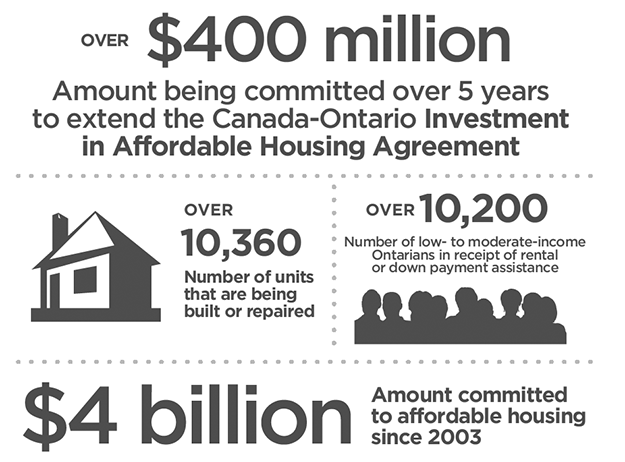
Federal housing funding: seeking a sustained, long-term solution
While we welcome the federal government’s continued investment in the Investment in Affordable Housing in Ontario program, we know that sustained effort is essential to combating homelessness and poverty. We continue to urge the federal government to return to the table as a long-term housing funding partner in the area of social housing, and to continue to work with us to build affordable housing. Our collective success demands long-term, sustainable and flexible housing funding.
Federal funding for existing social housing units in Ontario will decline from almost half a billion dollars annually to zero dollars by 2033. Without sustained federal funding, facilities deteriorate, necessary repairs and improvements cease, and families are put at risk of homelessness.
Declining federal investments in housing

When individuals and families have a home to call their own, they have improved health, education and employment prospects, and they are that much closer to exiting poverty.
Investing in what works: using evidence-based social policy and measuring success
Reducing poverty means investing in the right supports. Poverty is a complex issue, and our resources are limited. Making the most effective investments based on evidence, lessons learned and best practices is more important than ever.
Our government is committed to funding programs based on evidence. We must invest in programs and policies that demonstrate measurable evidence showing that they work to make people’s lives better. This requires us to improve methods and implement rigorous, ongoing evaluation to measure performance.
Together with our community partners, we will work to put a heightened focus on evidence-building in order to fund programs and interventions that work. We will challenge ourselves and our partners to work holistically toward better outcomes, and we will reward these efforts with a commitment to sustained funding for programs that achieve strong outcomes for people.
In short, we will spend money where it measurably improves the lives of people living in poverty. This principle is at the heart of good government and it will guide our success in poverty reduction.

The high cost of poverty
Poverty costs us all. In 2008, the total estimated annual public cost of poverty in Ontario was $10.4 billion, while the total estimated annual private cost was $21.8 billion.9 Clearly, there is a strong financial imperative for our province to break the cycle of poverty by lifting out those who are currently living in poverty, and by preventing others from ever falling into poverty in the first place.
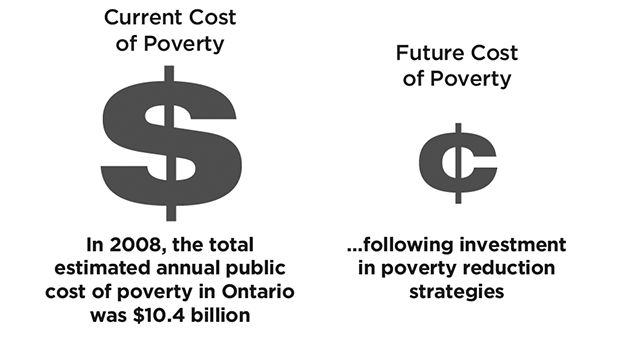

9 Ontario Association of Food Banks, The Cost of Poverty: An Analysis of the Economic Cost of Poverty in Ontario (November 2008), http://www.oafb.ca/assets/pdfs/CostofPoverty.pdf.
Local innovations: tapping community-specific knowledge
Reducing poverty is not a top-down effort. Poverty looks different in different areas of the province, and for different communities across Ontario, including, for example, urban and rural communities, Aboriginal communities and francophone communities. Under our first Poverty Reduction Strategy, we heard from our municipal and community partners about the value of tapping into local, community-driven solutions and fostering collaborative partnerships across Ontario. In response to this feedback, supporting innovative action at a local level to reach solutions will be central to our efforts under the new strategy.
Building on progress:
We’re investing $50 million over five years to create a new Local Poverty Reduction Fund targeted at supporting local solutions to poverty. The fund will support innovative poverty reduction efforts across the province. It will also help communities mobilize their efforts in poverty reduction by providing funding over the next five years to build on local strengths, address local needs and build evidence.
As we heard in our consultations, too much time is taken up by our community partners in writing grant applications and seeking short-term funding. To reward organizations that deliver consistent results, we will commit to more sustained funding.
We will work with a centre of excellence to guide, support and oversee these efforts to ensure proper accountability through evidence-building, reporting and information-sharing.
Social enterprise: doing business and doing good
Across Ontario, there are about 10,000 social enterprises — businesses that have a positive social, cultural or environmental impact while generating revenue. Of these businesses, 70 per cent are focused on poverty reduction. By investing and partnering in efforts that encourage and build social enterprise, and by piloting new social finance approaches, our government can leverage the efforts of those who are helping to lift people out of poverty and help build stronger communities.
Initiatives include the Ontario Catapult Microloan Fund, which provides financing for early-stage social enterprises, many of which create jobs for members of traditionally disadvantaged groups and offer innovative approaches to address the systemic challenges of poverty. The fund is a partnership between the provincial government and the not-for-profit and private sectors.
Building on progress:
We’re investing $4 million in the Social Enterprise Demonstration Fund, deployed in partnership with not-for-profit organizations working in communities across the province. These participating organizations will help leverage significant private-sector funding, and will provide grant and/or loan funding to early-stage social ventures to help them implement solutions to pressing social challenges.
Initiatives also include a commitment to work with private-sector investors to pilot one or more Social Impact Bonds, which provides an opportunity to leverage new funding for prevention-focused approaches that will result in improved outcomes for Ontarians in need.
Targets and goals: our continued commitment
In 2008, under our first strategy, we set an ambitious target of reducing child poverty by 25 per cent over five years. We did our part, and we made great progress. We helped reduce child poverty from 15.2 per cent in 2008 to 13.6 per cent in 2011, and, as a result of our efforts, 47,000 children and their families were lifted out of poverty in just three years, while 61,000 were prevented from falling into poverty in 2011 alone.
Building on progress:
We are recommitting to reducing child poverty by 25 per cent, using 2008 as our base year. Under our new strategy, we continue to call on the federal government to make a significant investment in poverty reduction, and to be a true partner on an issue that affects us all socially and economically.
We are committing to a bold and ambitious long-term goal of ending homelessness in Ontario. We will set a target to measure success. This new strategy provides us with an opportunity to expand on our original vision. We know that stable housing and related services are an essential foundation for the success of other interventions.
As we expand our focus to reduce homelessness under this strategy, we must be practical and understanding of the broader context. Achieving an end to homelessness will not happen overnight, but that doesn’t mean important work cannot begin right now. We are laying the foundation by seeking expert advice to develop new measures to track homelessness in Ontario. With the right information and the right tools, we will develop a plan to reach our goal. We will report back annually on our progress.
Indicators: tracking our progress
As we work to reduce poverty, adjustments to our approach will be needed as we collect evidence and understand what has worked and what has not been successful. By assessing where we have made gains, we will uncover lessons that we can apply and identify solutions that we can replicate elsewhere. By assessing where we have fallen short, we will be able to have important discussions about where a change in course or greater coordination is needed.
Ontario’s first Poverty Reduction Strategy included eight indicators that, taken together, offered a more accurate picture of the impacts of child poverty in Ontario. The indicators cover key aspects of opportunity such as health, education, income security, material deprivation and housing security. Under the first strategy, we made progress on all eight indicators.
We will continue to track seven of the eight indicators from the first strategy, where data continues to be readily available:
- birth weights
- school readiness (Early Development Instrument)
- educational progress (combined grade 3 & grade 6)
- high school graduation rates
- Low Income Measure (LIM50)
- Depth of Poverty (LIM40)
- Ontario Housing Measure10
Changes at Statistics Canada eliminated the survey that carried the Ontario Deprivation Index, making data on the existing Standard of Living indicator inconsistent and likely unavailable in future. We will continue to measure poverty as accurately as possible through existing and new indicators, in spite of a lack of key federal data, which has led to the removal of this indicator.
Building on progress:
We’re expanding our indicators to look more closely at youth education, employment and training, long-term unemployment, and the poverty rates of vulnerable populations.
The three new indicators are:
- Not in education, employment or training (NEET) — we will more closely track the percentage of youth and young adults who are not in education, employment or training. They are at higher risk of persistent poverty and social exclusion. In 2013, 11.6 per cent, or 316,200, of all youth and young adults aged 15 to 29 were in this category in Ontario
Not in education, employment or training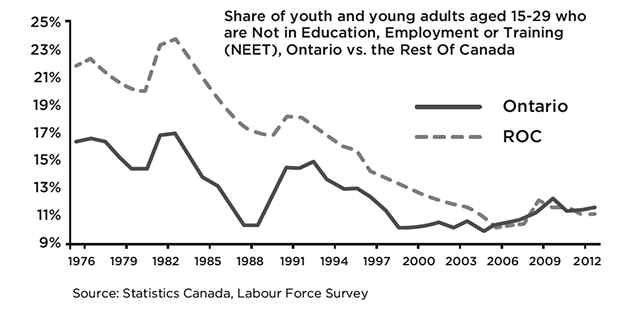
- Long-term unemployment — we will more closely measure the percentage of working-age Ontarians (aged 25 to 64) experiencing long-term unemployment. They are getting less work experience and are becoming disconnected from the labour market. In 2013, 1.8 per cent, or approximately 107,000, of all working-age Ontarians were experiencing long-term unemployment
Long-term unemployment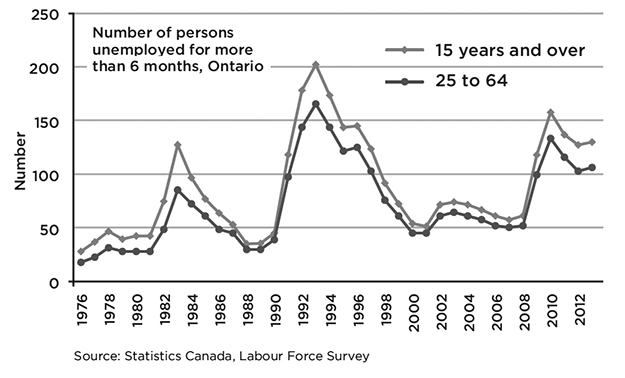
- Poverty rates of vulnerable populations — we will more closely track the poverty rates of several vulnerable populations. This will include Aboriginal people living off-reserve, newcomers, persons with disabilities, unattached individuals aged 45 to 64, and female lone parents. Of those people who are 16 years and older in Ontario and who live in poverty, 66 per cent, or 823,000 people, belong to one or more of these vulnerable groups. Tracking this indicator will give a clearer picture of how our interventions are impacting the most vulnerable in our province. In 2011, these vulnerable groups had an aggregate poverty rate of 19.4 per cent
Vulnerable groups with high poverty rates, Ontario, 2011
10 Due to changes at Statistics Canada, it is unclear whether the Province will be able to continue reporting on the Ontario Housing Measure. More information on the status of this indicator will be available once the Canadian Income Survey is released in fall 2014.
Compensating for a lack of federal insight
Poverty may be a human issue, but data is critical to address it. National poverty reduction efforts are hampered by federal decisions that have resulted in lower-quality data. The federal government has eliminated important surveys, such as the Survey of Labour and Income Dynamics and the mandatory long-form census, which were used to track outcomes among vulnerable groups. Researchers are concerned that the replacement surveys will not provide data that is as reliable or comparable, hindering effective policy analysis. We will do all that we can to continue to measure poverty as accurately as possible.
Tracking our progress: Ontario’s Poverty Reduction Strategy indicators
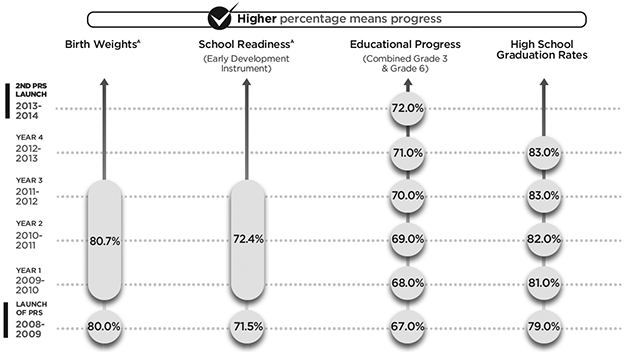
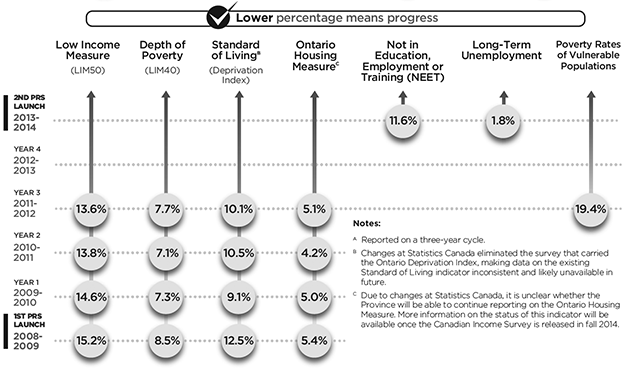
Annual reporting and oversight: providing strong leadership
Accountability and partnership are central to our government’s new Poverty Reduction Strategy. To ensure that we work together in our poverty reduction efforts, a representative group of ministers will continue to ensure ongoing oversight for the strategy. We will continue to publicly report annually on our progress. We will also engage in regular outreach to seek input and feedback from our partners on our efforts. And we will use this information to make improvements and adapt our work to have the most effective impact on low-income Ontarians across the province.
A strong federal partner: collaborating on solutions
A strong federal partner is necessary if Ontario is to meet our poverty reduction goals. Helping everyone to be at their best and to escape poverty should be a national enterprise. Through our new strategy, we are renewing our call on the federal government to be fair to Ontario, and to work collaboratively with us to develop and implement poverty reduction solutions that meet the needs of Ontarians.
We continue to:
- call on the federal government to increase the National Child Benefit Supplement
- highlight the need for a national child care program, and call on the federal government to recognize the links among child care, employment and poverty reduction, and to do their part to support opportunities for Ontario families
- call on the federal government to make further enhancements to the Working Income Tax Benefit, an earned income supplement that makes a difference in the lives of working low-income Ontarians
- urge the federal government to return to the table as a long-term housing funding partner in the area of social housing and continue to work with us to build affordable housing
- call on the federal government to reintroduce important surveys that provide data to help us track progress
In our consultations, we heard repeated requests for us to work with the federal government on poverty reduction. While the issues are complex, through commitment and collaboration between Ontario and the federal government, we know we can more effectively address issues related to income security and overall poverty reduction. By working together, we can help to realize the full potential of all Ontarians living in low income, to Canada’s benefit.
Conclusion
Realizing Our Potential reflects our conviction that, with the right supports, many people experiencing poverty can have brighter futures. It is a call to action for all Ontarians to help in this effort. It will succeed by mobilizing everyone’s unique ability to play a part in ending poverty — teachers, nurses, tradespeople, employers, elected officials, public servants, volunteers and so many others.
Addressing complex challenges can be filled with uncertainty. The global economy is always changing. The population of Ontario is not static. New opportunities are always emerging, and unexpected challenges may arise. Throughout Ontario’s history, we have made social and economic progress through every type of circumstance we have faced. In continuing to reduce poverty and in ending homelessness, we will do the same. We are determined. We will achieve successes, learn from failures and reset our sights on stated goals. We will trust in the ability of Ontarians to continue building up and realizing the potential of our province, and make it a home we can all be proud of together.